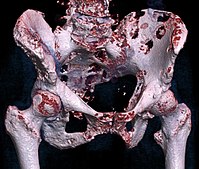
Photo from wikipedia
OBJECTIVE Although whole-body fluorine-18 fluorodeoxyglucose (18F-FDG) positron emission tomography (PET)/computed tomography (CT) (18F-FDG PET/CT) is commonly used for M staging of newly diagnosed nasopharyngeal carcinoma (NPC), some patients may not… Click to show full abstract
OBJECTIVE Although whole-body fluorine-18 fluorodeoxyglucose (18F-FDG) positron emission tomography (PET)/computed tomography (CT) (18F-FDG PET/CT) is commonly used for M staging of newly diagnosed nasopharyngeal carcinoma (NPC), some patients may not benefit from this procedure. The present study investigated which patients require this modality for M staging. METHODS Whole-body 18F FDG PET/CT results and clinical data were collected for 264 patients with newly diagnosed NPC. The relationships between distant metastasis and age, gender, pathological type, lesion size, SUVmax-T, T staging, N staging, SUVmax-N and Epstein-Barr virus (EBV) quantity were retrospectively analysed to identify factors associated with increased risk. RESULTS Of the 264 patients, only 37 (14.0%) were diagnosed with distant metastasis. Using multiple logistic regression analysis, EBV-positivity (OR=13.1; 95% CI:1.61,106.80), N staging (OR=3.05; 95% CI:1.41,6.63) and T staging (OR=2.16; 95% CI:1.10, 4.24) were significantly related to distant metastasis (all P<0.05). EBV DNA levels≥9000copies/ml, N3 stage and T4 stage were identified as high risk factors. A low risk of distant metastasis was found in patients with 0-1 risk factors and in those with 2 specific risk factors, T3/T4 and N2/N3 staging. Patients with EBV DNA levels ≥9000copies/ml and N3 or T4 staging and those with 3 risk factors had a medium or high risk, with a much higher incidence of distant metastasis (χ2=29.896, P=0.000), and needed a whole-body 18F FDG PET/CT for M staging. CONCLUSIONS Due to the low incidence of distant metastasis, only patients with medium or high risk need to undergo a whole-body scan.
Journal Title: European journal of radiology
Year Published: 2017
Link to full text (if available)
Share on Social Media: Sign Up to like & get
recommendations!